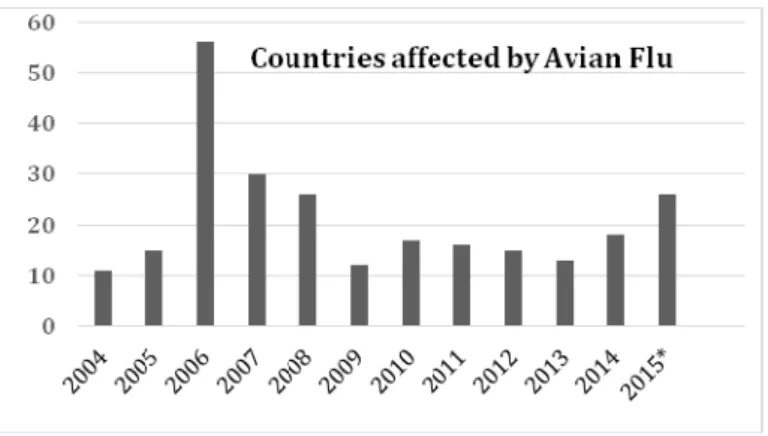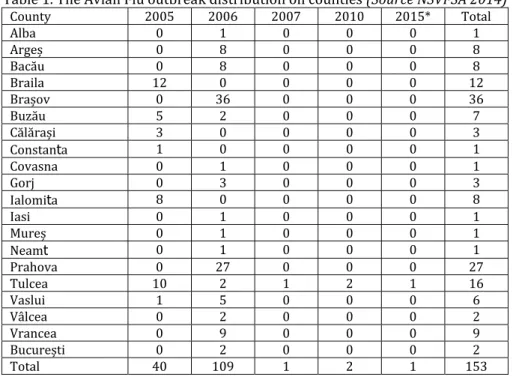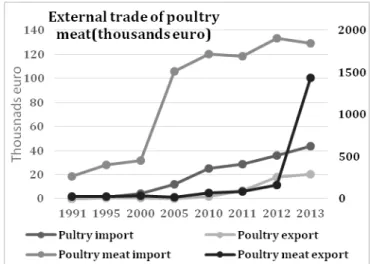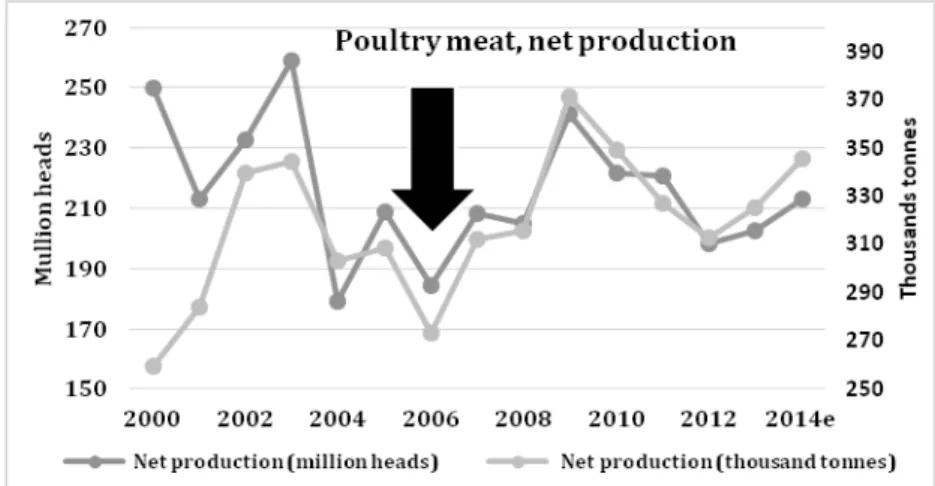THE AVIAN FLU IMPACT ON THE ROMANIAN POULTRY MARKET
Silvius Stanciu
sstanciu@ugal.ro
Dunărea de Jos University of Galati, Romania
The Bucharest University of Economic Studies, Romania
Roxana Sârbu
sarburoxana@yahoo.com
The Bucharest University of Economic Studies, Romania
Poultry meat represents one of the most dynamic branches of the local meat production. The poultry sector represents a good quality protein source, at an acceptable price as compared to other animal production domains. There has been an ascending evolution of the sector after the year , although there appeared a series of discontinuities that affected agricultural production, mainly on a short-term basis. The Avian Flu led to million euros worth losses at the level of Romanian national economy. Low consumption due to the impact was a short-term consequence, being rapidly amortized by the Romanian producers. The lack of some business continuity insurance measures can further affect the poultry meat sector, which does not have the necessary robustness needed in case of larger shocks. The following article proposes an analysis of the Avian Flu crisis economic effects on the Romanian meat sector, and it is part of a general framework of research regarding the Romanian food chain resilience to critical situations.
Keyword: poultry, Avian Flu, meat, market, BCM
JEL Code: E2, M1, Q180
Introduction
Poultry meat production and consumption has lately recorded a positive evolution, being among the most dynamic sectors in the meat sector. Poultry meat is a food product which is perceived as dietary by most consumers. Some epidemics, like the Avian Flu or the Newcastle disease, have affected the local poultry meat production and the consumers trust in these products.
Materials and methods
The research carried out for this paper mainly used official reports of national NSVFSA, USDA or international organisations O)E , with prerogatives in the field of food safety and animal health domain, reports of some well-known financial institutions World Bank , which were analysed and interpreted according to the specialised literature. The statistical information was taken from the national N)S or international FAO Stat, Eurostat databases, and then processed and interpreted. The media information was verified on the basis of some credible sources. The cost-benefit analysis, carried out by the World Bank, represented a useful tool in assessing the Avian Flu s impact on the local sector.
The spread of the Avian Flu
The most serious transmissible diseases, with a high degree of danger for the domestic and wild animals are the Avian Flu and the Newcastle Disease, which generate important economic losses due to a high death rate, to restrictions regarding bird movement and meat products. Besides these diseases, in confined production halls, specific to intensive poultry meat production, other infectious or parasitical diseases, specific to birds, can become manifest.
The recent outbreaks of Avian Flu in Europe The Agriculture Gazette, have brought
once again to the fore the effects felt by the local sector at the previous epidemic outbreaks. )n this respect, measures have been taken, such as: monitoring or banning imports from the risk-prone areas Germany, the Netherlands, and the UK , poultry periodic health status checking and intensifying controls regarding poultry farm biosecurity requirement appliance.
for Avian )nfluenza NSVFSA, . The programme implementation was achieved as a consequence
of a loan from the world bank of . million euro in the period – , which completed the
emergency help given by the EU to improve the surveillance for avian influenza in the country.
Figure . Countries affected By Avian Flu - April
(Source of data OIE, 2015)
The . million euro were distributed for animal health domain measures . million euro ,
for population health domain measures . million , for Public Awareness and Communications
. million , and . million euro for support, monitoring and evaluation, respectively. The Avian
Flu is an infectious disease caused by a mutation of the Type A influenza virus, subtypes ( and ( .
Discovered years ago in )taly, the Avian Flu spread all over the world, all the wild and domestic
species of birds being exposed to it.
Migratory birds are the virus spreading natural source, which are more resistant to the virus than poultry. After WW)), the disease became manifest only sporadically, only cases being recorded
in the time period – NSVFSA, . The last years brought back the disease and its
virulent manifestation in , affecting over million birds.
According to the data provided by O)E a , from until April , approximately
, outbreaks of (ighly Pathogenic Avian )nfluenza subtype ( N in poultry in Asia, Africa,
Europe and the Middle East have been recorded. The Asian area was the most affected, with ,
outbreaks recorded in Vietnam and , in Thailand. The situation of the countries affected by the
Avian Flu is presented in figure . The year , with affected countries, represents the period
with the most cases of Avian Flu, followed by the year . )n the first part of the year there
have already been countries in which the virus has been identified, equalling the situation from .
According to the NSVFSA data , in the interwar period, in Romania, cases of Avian Flu
are recorded in and in , respectively at the slaughterhouse from Burdujeni, Suceava.
Beginning with the year , new outbreaks of the disease have been recorded in Romania, their
evolution being presented in figure .
Figure . The Avian Flu outbreak evolution in Romania -April
The year brought a notification regarding the existence of the ( N virus in Romania at
a pelican colony in Dobrogea O)E, b . )n the period monitored by O)E there have been
notification issued by Romania towards the international community, by means of the Avian Flu world
alert system in the years , , , , . The situation of the Avian Flu outbreak
situation recorded in Romania, according to the data provided by NSVFSA and O)E a is
presented in figure . )n the monitored period there have been outbreaks, with a maximum
manifestation of the epidemic in the year , with cases. The most affected counties were
Brașov, Prahova and Tulcea.
Table . The Avian Flu outbreak distribution on counties (Source NSVFSA 2014)
County * Total
Alba Argeș Bacău Braila Brașov Buzău Călărași Constanta
Covasna Gorj )alomita
)asi Mureș Neamt
Prahova Tulcea Vaslui Vâlcea Vrancea București Total
Except for the areas transited by migratory birds, the epidemic outbreaks were recorded only once, the eradication measures taken avoiding further outbreaks in the following years.
Tulcea is the only county in which the disease was manifest every year when it was in Romania, due to the large population of wild migratory birds from the Danube Delta. The alert from
concerned a pelican colony, the poultry not being affected.
The poultry sector development in Romania at present
The decline of the primary production in Romania after the revolution affected all
sectors, including the poultry meat one. Although a poultry sector modernising process was begun
during the communist regime – , which led to a production capacity of almost kg of
poultry meat/urban inhabitant, the poultry industrial growth in Romania was confronted with a number of organizational issues or with a lack of good genetic materials.
The low price import product competition, coming from countries with tradition or from countries which grant subsidies to poultry farmers, the fodder low-quality and quantity, the imports made at the limit of legality, the high death rate and the longer production cycle led to the collapse of the sector. The lack of some efficient measures from the part of the authorities emphasized this status, Romania becoming practically dependant on imports. The constant growth recorded after the year
gave theRomanian poultry sector the fourth place in the world and the fourth place in Europe,
due to the technical performances achieved in .
Although production in the year records a plus of % as compared to , reaching
, tons, it is still % smaller as compared to . Cumulated with the production for own
consumption, the local poultry market is estimated at approximately , tons per year O)E, ,
World Bank .
The year is the year in which imports are exceeded by exports, Romania s balance being
decreased from % in to % in figure . A further decrease in point of domestic market
dependence of up to % is forecasted in Source AM PNDR, .
Figure . External trade of poultry and poultry meat
(Source NIS, 2015)
Between – , the total number of poultry reached a maximum in million as
compared to million in , but between – a descending trend was noticed, the total
number of poultry reaching million heads AM PNDR, . The quantitative growth in production
was due to the use in poultry farms of some heavy races, raised for meat and weight increase at slaughter. The local sector for egg poultry raising developed with difficulty, the total egg production
increasing in the period – with . %. The majority of Romanian consumption is ensured by
domestic production.
The main local poultry meat producers cover almost % of the market, having a turnover of
over million euro. Among these, only companies record a profit, with a total value of million
euro in . The share of the biggest poultry companies on the poultry meat market is presented in
figure . Specific to big producers is the development of an integrated production system, in which the company has its own fodder manufacturing units, its own poultry farms, slaughterhouses, processing units and, in some cases, its own stores.
VAT increase on finished products is achieved only by means of slaughter, cutting, packaging and preservation. The big companies form the poultry domain have secondary processing sectors in which they obtain high-value meat products as compared to raw materials.
Another tendency, which was noticed on the market, is the use of own production brands differentiated on categories of products Fragedo and Papane - Transavia, Coco Rico – Avicola Buzău or
Family chicken, (appy chicken, Anti stress chicken – Avicola Bacău Stanciu, .
The effects of the Avian Flu on the local poultry sector
The epidemic had direct effects on the poultry population mainly on the population s households , on the meat and egg production and consumption and indirect ones on tourism and on other sectors.
Figure . The effects of the Avian Flu on poultry number and production Source N)S,
The Avian Flu led to a decrease in the number of poultry and in poultry meat production figure , which was nevertheless overcome by local producers, taking into consideration the reduced production cycle from the poultry domain and live chicken imports.
The year records a production which was almost equal to the one obtained in the year
, previous to the epidemic outbreak.
Poultry meat consumption records a significant decrease from until , with a
minimum of kg./capita/year. The surveys conducted among consumers during the crisis highlighted their reluctance in purchasing poultry products. Losses in point of poultry meat consumption are also recorded by other national economies affected by the Avian Flu )taly, the USA , but there were
different approaches to the incident by the consumers Beach et al, .
)n fact, official statistics show that from until , only fish meat recorded a constant
growth, without fluctuations, although it was fairly reduced. All the others types of meat had a fluctuating evolution due to the incidents from the sector. Figure presents poultry meat consumption
reduction from until , due to the existing problems from the poultry sector.
Figure . Poultry meat consumption evolution during the Avian Flu Source N)S,
The cost-benefit analysis, carried out by the World Bank , highlights other loss
categories, connected to the poultry sector, such as the tourism sector one, assessed at million euro.
Overall, the losses recorded because of the Avian Flu epidemic were assessed at over million euro
Table . Fiscal impact and economic losses in the Romanian economy due to the Avian influenza
outbreak, - Euros ' (Taken from World Bank Report, 2006)
Cost Fiscal
costs
Economic losses Loss of productive assets
Value of poultry culled meat and eggs, at average prices ,
Compensation to poultry holders
Outbreak control and related expenditures
Outbreak operations disinfection, culling, incineration of poultry etc. , ,
Prophylactic treatment with anti-viral medication Tamiflu
Vaccination of humans , ,
Sanitary & protection equipment, information materials for protecting public health,
Road disinfection "filters"
Losses to the poultry industry due to interruption in production and collapsing markets
Production loss during the outbreak control period disinfection and
surveillance ,
Drop in poultry demand less sales ,
Depressed prices sales at lower prices ,
Export ban ,
Extra storage costs ,
Extra disinfection costs for commercial farms ,
Delays in production flows
Losses to other industries
Tourism ,
Total losses 56,322 193,119
Conclusions
The Avian Flu outbreak highlighted the frailty of the local poultry sector, which, although recorded some progress in the last years, it didn t develop the necessary resilience to absorb strong shocks, such as animal epidemics. The subsequent manifestation of other critical incidents the Newcastle Disease, the altered meat scandal or the turkey meat pollutants identified in the Romanian products for export prove the lack/inefficiency of some measures taken to ensure business continuity in the animal production sector.
The poultry meat market has a low degree of concentration, the main competitors not going over the critical threshold of %. Although poultry meat consumption decrease was a drastic one
during the crisis, the period from until led to a recovery of the recorded losses, a historical
maximum for the Romanian market being recorded in . The total losses associated with the Avian
Flu for the time period October – May , were estimated at million euro. Together with
the poultry producer direct losses there were some costs associated with the intervention of the authorities or the influence on some connected sectors, such as tourism, with estimated losses of million euro. Although the crisis was a short one, consumer reluctance towards poultry products led to a decrease in request on the Romanian market of over million euro. The critical incidents, such as the animal epidemics, impose the intervention of authorities and radical measures in order to prevent disease transmission among population.
Acknowledgements: This paper was co-financed from the European Social Fund through Sectorial
Operational Programme (uman Resources Development - , project POSDRU number
/ / . /S/ "Excellence in scientific interdisciplinary research, doctoral and postdoctoral
school, in the economic, social and medical fields-EXCEL)S", coordinator The Bucharest University of Economic Studies.
Reference
2. Beach, R., Kuchler, F., Leibtag, E and Zhen, C, 2008,The Effects of Avian Influenza News on Consumer Purchasing Behavior. A Case Study of Italian Consumers’ Retail Purchases, United States Department of Agriculture, Economic, Research Report No. 65, [pdf], Retrieved February, 2015,
www.ers.usda.gov/publications/err.../err65.aspx, ;
3. The Agriculture Gazette, 2014, Preventive measures in the poultry farms as a consequence of the Avian Flu evolution in the EU, [online], Retrieved January, 2015,
http://www.gazetadeagricultura.info/animale/pasari/16857-masuri-preventive-in-fermele-de-pasari-ca-urmare-a-evolutiei-gripei-aviare-in-ue.html;
4. National Institute for Statistics NIS, 2015, Tempo online. Statistical data series. [online], Retrieved April, 2015, http://statistici.insse.ro/shop;
5. National Sanitary Veterinary and Food Safety Authority (NSVFSA), 2007, The Avian Flu National Contingency Plan for Romania/The Avian Flu Operational Manual, [pdf], Retrieved December, 2014, http://www.ansvsa.ro/documente/admin/Planul%20de%20Contingenta%20Gripa%20Aviara_ 26893ro.pdf; 6. National Sanitary Veterinary and Food Safety Authority (NSVFSA), 2014, The Avian Flu risk analysis for poultry
in Romania, [pdf], Retrieved December, 2014, http://www.ansvsa.ro/upload/admin/altele/ analiza_risc_gripa_aviara_pasari_domestice_2014.pdf;
7. Pâlșu, M, 2014, Lady Harvard, Avicola Buzău şi cacealmaua profitului reinvestit, Puterea (29.06.2014), [online] Retrieved Marrch, 2015, http://www.puterea.ro/dezvaluiri/studiu-de-caz-lady-harvard-avicola-buzau-si-cacealmaua-profitului-reinvestit-95258.html ;
8. Stanciu, S., 2014, Romanian poultry meat market analysis, International Scientific-Practical Conference "Food, Technologies & Health", 2014, Proceedings Book;
9. World Bank, 2013, Avian Influenza control and human pandemic preparedness and response project under the global program for avian influenza (GPAI), Report No.: 78781 [pdf], Retrieved January, 2015, https://ieg.worldbankgroup.org/Data/reports/PPAR-78781-P100470-Romania_Avian_Influenza.pdf;
10. World Organisation for Animal Health (OIE), 2006, Economic analysis . Prevention versus outbreak costs .Final Report Part I, [pdf], Retrieved March, 2015, http://www.oie.int/fileadmin/Home/eng/Support toOIE _Members/docs/pdf/ OIE_-_Cost Benefit_Analysis__Part_I_.pdf;
11. World Organisation for Animal Health (OIE), 2015, Romania. Notification to OIE (March, 15, 2015) [online], Retrieved April, 2015,
http://www.oie.int/wahis2/public%5C..%5Ctemp%5Creports/enfup_000001760820150428152249. pdf; 12. World Organisation for Animal Health (OIE), 2015, Update on highly pathogenic Avian Influenza in animals



